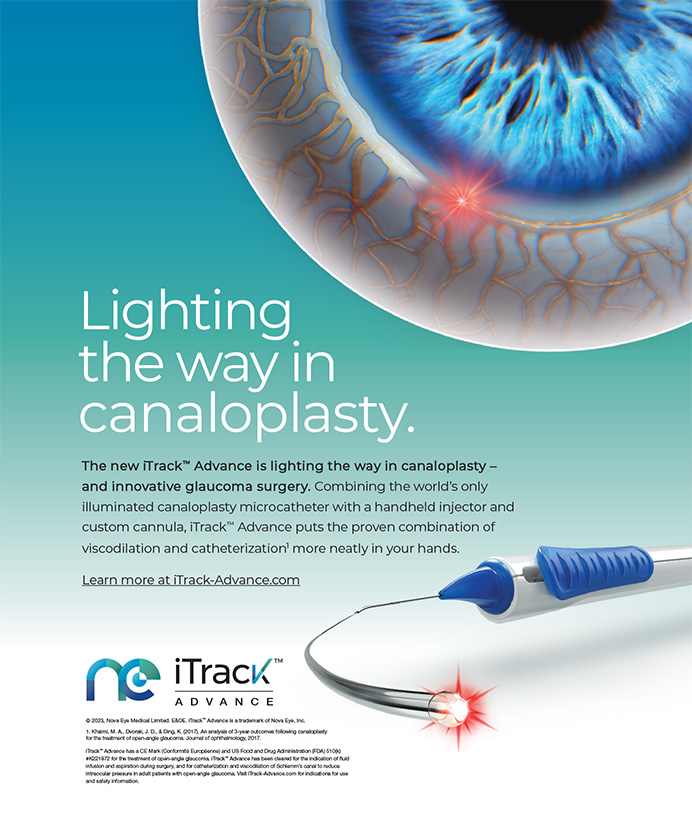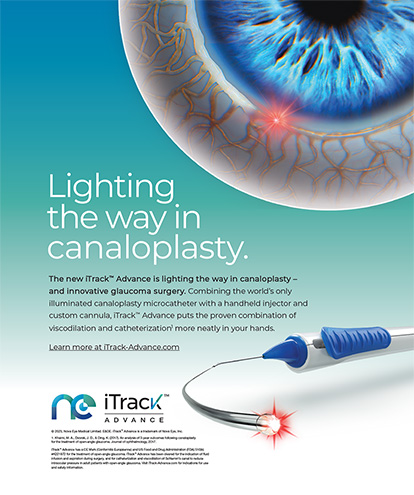CASE HISTORY
The case in question is that of a 73-year-old white man who fits into two of the above-mentioned categories, as he is an individual who functions primarily with one eye and who has a malpositioned IOL. The patient has long-standing chronic open-angle glaucoma with visual field loss. The involved right eye has had two prior glaucoma filtering operations. In between the two glaucoma surgeries, he also required cataract extraction with lens implantation. Following his latest glaucoma surgery, performed approximately 2 years earlier, the IOL shifted temporally to where the visual axis is close to the nasal edge of the IOL.
The left eye has also had glaucoma surgery, but has lost central vision as a result of advanced glaucoma damage; vision is not improvable beyond 20/200. The involved right eye has a best-corrected visual acuity of 20/60, resulting from the malpositioned lens. The visual field analysis demonstrates a superior nasal step without central involvement. Glaucoma control is somewhat tenuous in that intraocular pressure is maintained at 15 mm Hg with two topical anti-glaucoma agents. There is a moderately functional filtration bleb superiorly. The patient notes particular difficulty in nighttime driving. Attempts to improve visual function with topical miotics have failed to improve the patient's functional vision. The referring ophthalmologist requested that all attempts be made to salvage function of the filtration bleb. Therefore, the challenges in management of this patient's problem include 1) improvement in visual function by repositioning the IOL (three-piece silicone IOL; Allergan SI-40®, Allergan Surgical, Irvine, CA), 2) maintenance of glaucoma control, and 3) risks as a primarily uniocular patient.
REPOSITIONING THE IOL
The difficulty in surgical management is based on the fact that almost any manipulation of the conjunctiva can result in loss of function of the filtering bleb. Additionally, a large-incision surgery could also potentially reduce function of the glaucoma filter. Therefore, I considered repositioning the IOL by suturing it to the iris rather than replacing it or suturing it to the sclera. Certainly, an anterior chamber lens would be contraindicated in this patient because of his glaucoma. My surgical plan was to reposition the lens, remove vitreous if necessary, suture-fixate the lens to the iris, and attempt to enhance glaucoma filtration by manipulation of the internal ostium of the previous glaucoma surgery.
SURGERY
Initially, I used a retinal endoilluminator held externally to help identify the presence or absence of vitreous in the anterior chamber. This represents the best method in my own experience. I noted that there was no vitreous in the anterior chamber at the beginning of surgery. I performed two paracentesis in clear cornea using an MVR blade so that I could use vitrectomy instrumentation to the same opening if necessary. I added a retentive visco agent and used two Sinskey hooks through the paracentesis to rotate the IOL from its temporal malposition into the center of the pupil. I noted that the lens had been previously placed in the ciliary sulcus, that it had no adhesions to the underlying capsule, and that the capsule was absent nasally.
Once I rotated the lens into the pupillary space, I brought the optic anteriorly into the anterior chamber and constricted the pupil with Miochol® (Novartis Ophthalmics, Atlanta, GA) leaving the loops in the posterior chamber. This form of optic capture allows the surgeon to identify the position of the loops behind the iris. Next, using 10–0 polypropylene sutures, I performed standard McCannell suturing to both lens loops creating a stable, central position of the lens. I then repositioned the optic behind the pupil. Fortunately, I never had to remove vitreous from the eye.
The next challenge was to enhance the glaucoma filtering procedure. Working with a four-mirror gonioprism, I placed a blunt probe through the inferior paracentesis across the anterior chamber and into the original surgical ostium. I removed the gonioprism and used the probe to sweep adhesions between the sclera and conjunctiva. In my view, it is imperative to place the probe under control of the gonioprism. Otherwise, it is possible to induce a cyclodialysis with the potential for significant bleeding. Once I was able to pass the probe into the ostium, I also used the same avenue to inject viscoelastic to further expand the filtering bleb. Finally, I injected 5-fluorouracil subconjunctivally from the external aspect of the eye in an attempt to prevent further adhesions from forming in the postoperative period. I removed the visco agent from the chamber through the two paracentesis, hydrated those incisions, and re-established intraocular pressure to physiologic levels with BSS® (Alcon Surgical, Fort Worth, TX).
OUTCOME
Fortunately, the patient did very well in the postoperative period. Intraocular pressure control has been improved to where only one topical medication is employed and intraocular pressure is maintained at 12 mm Hg. Additionally, the patient's visual function has been improved in that he can now drive at night, and his central visual acuity has been improved from 20/60 to 20/20. It has been approximately 1 year since the patient's surgery, and the referring physician has assured me that he continues to do well.


